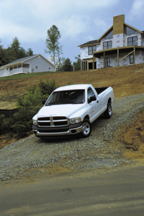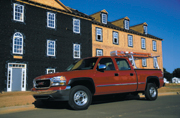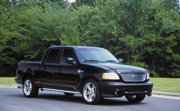

With the work on the structural/body portion of the trucks mostly finished, the manufacturers are turning their focus toward technological refinement of the mechanical support systems, as evidenced by the introduction of features such as four-wheel steering and work by several manufacturers on hybrid drive train systems.
If there's a bright spot to the current slump in consumer sales of light trucks, it's the newly lowered prices on a wider selection of work-ready truck models. The sales volume driven by the previously strong consumer market enabled manufacturers to cost-effectively develop a vast array of specialty vehicles that would not have been possible based solely on the work truck market.

Highlights
Here's a look at what's new in light-duty work trucks for 2002:Dodge Ram 1500
After years of strong sales of the existing Ram pickup, Dodge was beginning to fall behind its competitors, many of whom have introduced all-new pickup models in the last few years. Well, Dodge has proved that good things come to those who wait. Beginning with the introduction of the completely revised Ram 1500 this year, the entire lineup will be updated over the next year or so.
The Ram's exterior is a refinement of the existing style, with some big changes to the truck's cab. Rather than following the industry trend of offering three different cab styles, Dodge has done away with the intermediate extended cab, opting instead to offer only regular cab and crew (Quad) cab models. The regular cab model breaks from tradition by extending the back of the cab slightly to provide more room. While it's not readily apparent from the outside, there's enough room behind the seat to store items as large as a 5-gallon pail and still move the seat back far enough to accommodate a tall driver.
Underneath, the new Ram benefits from the latest in hydroformed frame-rail technology, producing a solid stable feel to the whole truck. Power for the Ram 1500 will be provided by a choice of the 3.7-liter V6, a 4.7-liter V8, or the 5.9-liter Magnum V8, all routed through either a five-speed manual or a four-speed automatic transmission. Both 2WD and 4WD will be available on both the regular cab and Quad cab models. Both cab configurations can be equipped with either a 6.25-foot or 8-foot cargo bed.
On the ground, standard 17-inch wheels, along with standard rack and pinion steering, contribute to responsive handling, while an independent front suspension on 4WD models helps to smooth the ride. Large four-wheel disc brakes provide stable stops, even when carrying a load.
Although horsepower ratings for the Ram 1500 are a bit tame compared to the competition, industry insiders have indicated that some significant improvements to Dodge's engine lineup are forthcoming as a result of parent-company Chrysler's merger with Daimler. Look for the early results of this when the heavier 2500 and 3500 Ram models debut next year.
GM Pickup Line Expansion
GM continues to expand its T800 pickup line (Silverado and Sierra) with additional models and features. Most notable for this year is the addition of the 1500HD series, which brings the crew cab and Vortec 6.0-liter engine into the half-ton weight class. The 1500HD answers the needs of truck owners who want passenger and cargo volume, but don't need the heavy-duty suspension used on other GM full-size crew cab models.
Although production dates are uncertain at this point, GM has exhibited two production-ready powertrain systems that will likely appear in pickup models over the next few years.
The first is a "parallel hybrid" powertrain that incorporates an electric motor/generator unit between the truck's engine and transmission. The intent of this system is to allow the engine to be shut off while idling at an intersection and then instantaneously restarted when leaving the intersection, presumably saving some fuel. When the "integrated starter-generator" isn't starting the engine, it's used to charge a 42-volt battery system that is capable of powering electric power steering and air-conditioning systems, reducing the accessory load on the engine.
A side benefit that would be of particular interest to contractors is the system's ability to produce about 4,000 watts of 120-volt AC power when the vehicle is parked with the engine left running. Granted, the cost of this system exceeds that of a 4,000-watt portable generator, but the main intention is fuel savings.
Another of GM's engine technology programs involves "Displacement On Demand." This system is incorporated into a standard V8 engine with few significant changes, allowing half of the cylinders to be shut off when the truck is not accelerating or otherwise in need of full power. During a recent test of the system, we drove a DOD-equipped pickup through a city/highway course of just over 18 miles, during which the system switched seamlessly between the four- and eight-cylinder modes a total of 143 times, for a total of nearly 11 miles in the four-cylinder mode.
If not for a DOD indicator light on the dash installed for demonstration purposes, the change between modes would have been completely transparent. The system exhibits no lag whatsoever when throttle input causes a return to the eight-cylinder mode. The DOD technology should deliver significant fuel savings in any situation except rapid-cycle stop-and-go traffic. Because the DOD hardware is internal to the engine, the system would likely be incorporated as a standard feature on truck models in the near future.
Chevy Avalanche
The new Chevy Avalanche is just the first of what will likely become an entire market segment of pickup/SUV hybrids. What separates the Avalanche from the typical crew cab or SUV is Chevy's Convert-a-Cab System. The Convert-a-Cab features a "Midgate" and a storable rear window between the rear seat and the cargo area. Combined with folding rear seat, these features allow the Convert-a-Cab to be reconfigured into any of several permutations in seconds, by one person, without tools.
In its standard configuration, the Avalanche provides a crew cab's comfortable seating for up to five passengers, as well as a 5-foot-3-inch-long cargo bed. A lockable tailgate and stowable three-piece cargo cover allow for SUV-secure storage in a pickup-durable cargo area.
For those occasions when hauling 4-foot-by-8-foot sheets of drywall becomes necessary, the rear seats and Midgate are folded out of the way to extend the capacity to a full 8 feet 1 inch, with the tailgate closed. Using the cargo cover in this mode provides weathertight protection for your building materials when Mother Nature isn't cooperating with your project schedule.
Even more room is available for carrying taller items when the rear window is removed and stowed. To survive the rugged use that goes along with adaptable capabilities, all of the Avalanche's cargo surfaces, including the Midgate and cargo cover, are constructed of the same Pro-Tec composite material that made its debut on the 2000 Silverado. Normally wasted space around the rear wheel wells has been incorporated into two "top box" lockable storage compartments providing an additional 5 cubic feet of watertight storage.
Our preliminary testing of the Avalanche included hauling an extensive variety of building materials and tools, employing several different configurations of the cab and bed. While the initial launch of the Avalanche will be limited to half-ton models equipped with the Vortec 5300 engine, a 2500-series model (3/4-ton) equipped with the Vortec 8100 is slated for introduction in early 2002.

Other light-duty news
FordApart from a few commemorative/ special-interest editions of existing models, Ford's pickup lineup is basically unchanged for 2002. Air conditioning has been made standard on F-150 XL models, and a "4x4 Work Truck" option group is available with all-terrain tires. The 4.10 axle ratio is now available on the 7700 (GVW) package to increase the truck's GCW to 15,000 pounds.
Manual transmissions on the F-250/350 have been upgraded from 5-speed to 6-speed and automatic transmission equipped models will now feature a standard transmission temperature gauge incorporated into the instrument cluster.
Ford Division's Lincoln sibling will begin offering its version of the F-150 SuperCrew in the form of the Lincoln Blackwood. Changes incorporated in the Lincoln version include using Excursion-style "dutch doors" on the rear in place of the tailgate, and the addition of a power-operated tonneau cover on the cargo box.
GMC
For 2002 the Sierra C3 becomes the Sierra Denali, recognizing the addition of the Quadrasteer four-wheel steering system as standard equipment. The Sierra Denali will continue the C3's strong-chassis, soft-suspension (heavy half) configuration. The Quadrasteer system offers four-wheel steering in two different modes, in addition to conventional front-wheel steering.
At slow speeds, for tight-quarters maneuvering, the front and rear wheels turn in opposite directions (relative to the vehicle centerline), similar to the steering arrangement used on front-end loaders. This mode reduces the overall turning radius substantially. As a point of comparison, the standard '01 Sierra has a turning circle of just over 46 feet, while Quadrasteer reduces that figure to less than 37.5 feet, making the truck as maneuverable as a Saturn Coupe.
At highway speeds, all four wheels turn in the same direction (again, relative to the vehicle centerline). This "crab" steering allows the truck to perform lateral maneuvers, such as lane changes, quicker and with more stability, especially while towing.
Nissan
After restyling the front-end of the 2001 Frontier, Nissan is following up this year by adding a long-bed option to the Frontier crew cab. Where most of the competitive compact crew cab models are limited to an under-5-foot cargo bed, the Frontier crew cab is now available with a long bed that measures just over 6 feet long. Regular cab models are no longer available as the company is focusing its efforts on the more popular extended (King) cab and crew cab models.
Toyota
Following on the introduction of its compact crew cab "Tacoma Double Cab" model last year, Toyota's Tundra and Tacoma pickups are basically unchanged for the 2002 model-year.


